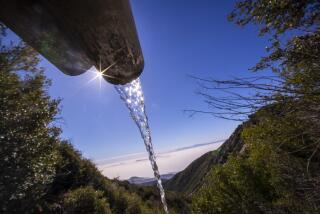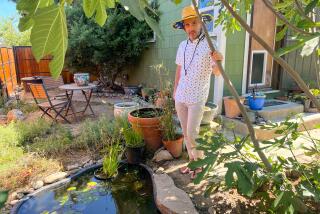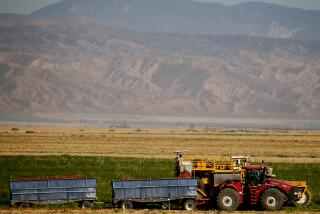Game Effort : Artificial Water Holes Bring Relief to Wildlife Left High, Dry in Forest
LOS PADRES NATIONAL FOREST — How does somebody get a drink around here?
For humans, it’s just a short stroll to the refrigerator for a pitcher of iced tea or can of soda. Anyone living in this desert that is Southern California needn’t exert any more effort finding water than turning on a faucet or twisting a bottle cap.
But for animals living in local forests, finding drinkable water is a crucial daily quest. On the fringe of civilization, just miles from humanity’s pools, ponds and automatic sprinklers, many creatures go thirsty. The continuous pumping of ground water for agricultural and residential use has sucked some water tables dry, causing some surface ponds to drain away.
To make matters worse, in dry years like this one (the last local rainfall of any significance came in January, according to the U.S. Forest Service) animals face an even more withered environment.
To make up the lack, the Santa Clarita Valley chapter of Quail Unlimited, a national conservation group, along with the U.S. Forest Service, has been building artificial water holes or “guzzlers” in the parched hills of Los Padres National Forest.
“At the turn of the century, this area had nice surface water sources,” said Maeton Freel, a Forest Service wildlife biologist who works in Los Padres. “In dry years water also was available from underground sources that wildlife was able to get to. Those aquifers produced better vegetation and foliage that also provided moisture. Much of that is gone.”
The Santa Clarita chapter of Quail Unlimited is made up of mostly of hunters but leaders of the group say that nonhunters and other conservationists belong to the 140-member organization that has banded together to help save wildlife.
On Saturday, about 25 members gathered in the wilds of Los Padres to raise forms and pour cement to help build their fourth and last guzzler of the year. In the past four years, they have built 22 guzzlers.
“Conservation out West is all about water,” said the group’s vice president, Bruce Kenyon. “Back East, they have all the water their animals need, but we have to focus on creating water sources because there just aren’t enough.”
The group constructs different guzzlers for big and small game. Pheasants, wild turkeys, quail, rabbits and raccoons use the small-game guzzlers and another type is built for deer, mountain lions, bears and bobcats.
Small-game guzzlers look like drained wading pools about 16 feet across.
A cement basin catches water in the winter and stores it in 900-gallon underground tanks to be used during summer months. Water is diverted to big-game guzzlers, which are connected by pipes about 15 feet away, and look like troughs. The water level in the big-game guzzlers is controlled by a float, much the way a toilet tank works.
Small animals and birds get to the water by walking down a ramp and drinking from a small reservoir underneath the unit’s cement cover designed so only smaller animals can fit, not the larger creatures that prey on them.
John Nelson, one of the group’s habitat experts, said a unit used by a different chapter once trapped a thirsty coyote.
“The coyote got in and drank too much,” Nelson said. “He drank so much that he was too fat to get out.”
The group says it does much to ensure the safety of the animals. The access ramp has a rough surface so paws and claws won’t slip on slick cement. Brush piles are collected nearby so smaller creatures have someplace to hide in case a red-tail hawk or prairie falcon perches nearby.
Most important, every effort is made to veil the guzzlers from would-be vandals or unscrupulous hunters, Kenyon said. Freel said there have been instances where hunters have set up blinds near the guzzlers and picked off game while they drank.
Nelson said that kind of hunting is not only illegal but disdained by legitimate hunters.
“People who say we do this just so we have more game to hunt are wrong,” said Michael Brinkman, the group’s spokesman. “All kinds of animals use our guzzlers. We’re happy to see coyotes and skunks or even kangaroo rats use them. This is about conservation, not about hunting.”
There is nothing sweeter then hearing the “chuck-chuck-chuck” of the chukar, an orange-beaked upland bird, Nelson said, as it drinks from one of the guzzlers he helped build.
“It’s definitely a labor of love,” he said.
It costs about $1,900 to build each guzzler. The group raises money by holding fund-raisers, shooting contests and dog-training clinics and donates all the labor, about 790 hours a year, group leaders said.
The Forest Service contributes matching funds and also helps with some of the construction, according to Freel.
Brinkman said it would cost the Forest Service about $10,000 to build a guzzler itself.
On Saturday, near the Lockwood Valley region of the park, volunteers were busily working among the shrubs and scrub oak and pine trees in a remote section of the forest. Richard Howell, a U.S. forest ranger, said the guzzlers are already having an effect on the growth of wildlife populations.
“We have wildlife in areas we didn’t have before,” Howell said. “We check the guzzlers and find footprints of animals that were not previously known to inhabit the area. The guzzlers aren’t just servicing animals that live here, they are helping animal populations expand.”
More to Read
Sign up for Essential California
The most important California stories and recommendations in your inbox every morning.
You may occasionally receive promotional content from the Los Angeles Times.










